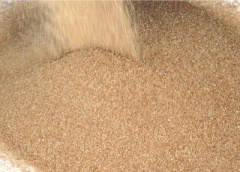Zirconsand
| Infobox on Zirconsand | |
|---|---|
| Example of Zirconsand |  |
| Facts | |
| Origin | Australia and the Far East |
| Stowage factor (in m3/t) |
|
| Humidity / moisture | - |
| Ventilation | - |
| Risk factors | See text |
Zirconsand
Description
Zircon (including hyacinth or yellow zircon) is a mineral belonging to the group of nesosilicates. Zircon forms in silicate melts with large proportions of high field strength incompatible elements. For example, hafnium is almost always present in quantities ranging from 1 to 4%. The crystal structure of zircon is tetragonal crystal system. The natural colour of zircon varies between colourless, yellow-golden, red, brown, blue, and green. Colourless specimens that show gem quality are a popular substitute for diamond and are also known as "Matura diamond".
Zircon is a common accessory to trace mineral constituent of most granite and felsic igneous rocks. Due to its hardness, durability and chemical inertness, zircon persists in sedimentary deposits and is a common constituent of most sands. Zircon is rare within mafic rocks and very rare within ultramafic rocks aside from a group of ultrapotassic intrusive rocks such as kimberlites, carbonatites, and lamprophyre, where zircon can occasionally be found as a trace mineral owing to the unusual magma genesis of these rocks.
Zircon forms economic concentrations within heavy mineral sands ore deposits, within certain pegmatites, and within some rare alkaline volcanic rocks, for example the Toongi Trachyte, Dubbo, New South Wales Australia in association with the zirconium-hafnium minerals eudialyte and armstrongite.
Australia leads the world in zircon mining, producing 37% of the world total and accounting for 40% of world EDR (economic demonstrated resources) for the mineral. This country is the leading producer and exporter of zircon which is obtained as byproduct of rutile recovery from the beach-sands. The largest concentration of such sands is found on the eastern coast, extending over 160 km, in Queensland. Concentration of such sands is observed in the Byoon Bay, New Brighton-Cudgera, Cudgen and Currimbin-Southport area and on North Stradbroke island. It is reported that on this island the heavy sands contain about 25% zircon. Deposits are worked by several companies. Australian deposits are wide-spread and quite large.
Application
Zirconsand is used in the process of hardening steel, etc.
Shipment / Storage
Mostly in bulk.
Risk factors
No special hazards. This cargo is non-combustible or has a low fire-risk. Zirconsand shall be kept as dry as practicable before loading, during loading and during the voyage. Consult the IMSBC Code (International Maritime Solid Bulk Cargoes Code) for overseas transport advice.











